Fingerloop Braiding
Fingerloop braiding is one form of the technique of loop manipulation, which can be used to make braids of all sizes and complexities.
This type of braid was very common in medieval London (Crowfoot et al. 1992). They were used as edging on mesh hairnets, purse strings, and for fastening clothing. Examples of 5, 7, 10, 14, and 20 loops have been found. All were of silk, mostly monochrome, but one used 2 colors. Fingerloop braids of 3 and 4 colors are known from elsewhere.
Getting started: These directions are for 5-loop braids (10 strands). Take 5 lengths of yarn, double them over, and tie the ends to something. Hold your left hand palm up, and put one of the five loops over your second, third and fourth fingers (middle, ring, pinkie). Also hold your right hand palm up, and put the last two loops over your second and third fingers, one loop for each finger.
Braiding: If you tip your hands slightly toward each other, you will see that each loop now has a top and a bottom. Reach your right index finger (which doesn't have a loop) through the two loops on your right hand, pick up the inside loop (from your pinkie) on your left hand from the bottom, and pull it back through. The loop twists as you transfer it from your left to your right hand.
Now you should have two loops on your left hand, on your second and third fingers, and three loops on your right hand. Move the loops on your right hand so that they are over your second, third and fourth fingers, leaving your index finger free. This can be done one-handed by "walking" them down, which is easier to do than to explain.
Repeat the first step of the braid, but with the hands reversed. With your left index finger, reach through the two loops on your left hand, pick up the inner loop on your right hand from the bottom, and bring it back through. Walk down the loops on your left hand.
You should be back to the initial starting position.
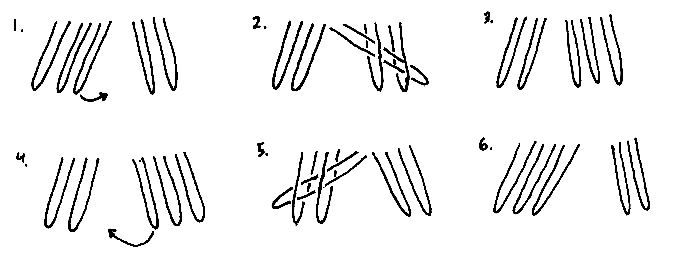
This diagram shows the 5 loops in their slightly tilted positions, and also shows how the moving loop travels through the other loops.

This is the braid that goes with the directions above.
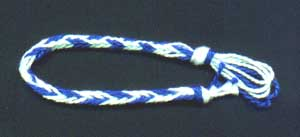
If you pick up the inner loop from the top, so that it is not twisted, you will make two separate 5-strand braids instead of one 10-strand braid. This is a useful way to put slits in your braids for fastening, decoration, etc.
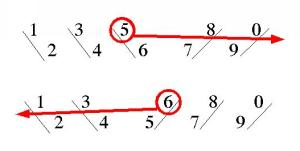
Half-round
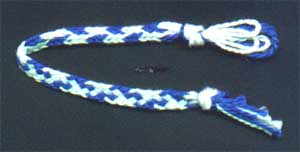
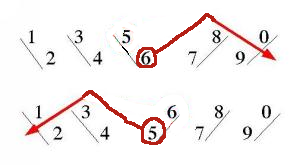
Spiral
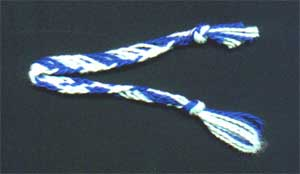
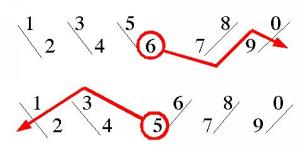
Flat
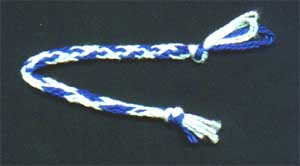
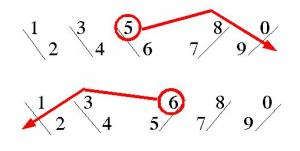
References
Bernald, Susan Scott. 1978. Slentre braiding. Shuttle Spindle & Dyepot
34:63-67.
Includes all these 5-loop braids, but uses the palms-down method.
Cahlander, Adele. 1985. A detective story: unravelling the mystery of a 7-loop braid. The Weaver's Journal Summer:12-13.
Cason, Marjorie and Cahlander, Adele. 1976. The Art of Bolivian Highland
Weaving. Watson-Guptill, New York.
Includes the 5-loop square braid, traditionally found all over the
world.
Crowfoot, E., F. Pritchard and K. Staniland. 1992. Medieval finds from excavations in London: 4. Textiles and clothing c.1150-c.1450. HMSO, London.
Kinoshita, Masako. 1986. A braiding technique documented in an early
nineteenth-century Japanese treatise "Soshun Biko." Textile Museum
Journal 25:47-65.
Braids with more loops, made by placing the loops over the hands instead
of on the fingers.
Speiser, Noemi. 1985. Unusual braids produced by loop manipulation. The
Weaver's Journal Summer:15-18; 67-72.
A more technical discussion of loop braids with directions and examples.
Speiser, Noemi. 1997. The Manual of Braiding. Fourth Edition.
Self-published.
Technical discussion of all types of braiding.
Speiser, Noemi. 2000. Old English pattern books for loop braiding.
Fourth Edition. Self-published.
Exactly as described in the title - excellent book.
Stanley, E.G. 1974. Directions for making many sorts of laces. Pp.
89-103 in: Rowland, Beryl (ed.). Chaucer and Middle English Studies.
Kent State University Press.
Transcription of a 15th century patternbook in Middle English, but not
too hard to follow.
